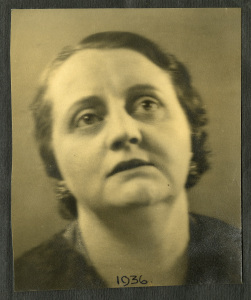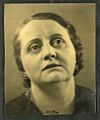Winifred Horrabin facts for kids
Winifred Horrabin (1887–1971) was an important British writer and activist. She believed in socialism, which is a way of organizing society where everyone shares resources and works together for the good of all. Winifred was also a journalist, meaning she wrote for newspapers and magazines.
Early Life and Education
Winifred was born in Sheffield, England, on August 9, 1887. Her father, Arthur John Batho, worked as a postal telegraph clerk. She was one of six children. When Winifred was young, her father passed away in South Africa.
In 1907, Winifred started studying at the Sheffield School of Art. Here, she met Frank Horrabin, who would later become her husband. He was also a political activist, a mapmaker, and a cartoonist.
Discovering Activism
While at art school, Winifred became very interested in politics. She was inspired by Olive Schreiner, a writer and activist from South Africa who supported socialism and women's rights.
Winifred joined the Women's Social and Political Union. This group was led by Emmeline Pankhurst and fought for women to have the right to vote. In 1909, Winifred even interrupted a speech by Winston Churchill to shout "Votes for women!"
Marriage and Political Work
Winifred and Frank Horrabin got married on August 11, 1911. They moved to London that same year. Winifred continued her activism, focusing on women's rights and workers' education.
In 1912, she gave a speech to the Fabian Society, a group that promoted socialist ideas. She argued that women could only truly be free if society changed how it handled private property.
Supporting Workers' Education
Winifred and Frank were both involved with the Central Labour College. This college aimed to educate working-class people. In 1913, Winifred created a Women's League. Its goal was to help educate women who worked.
She was also a big supporter of guild socialism, an idea inspired by the artist William Morris. This idea suggested that industries should be run by workers' guilds, not by private owners. Winifred was a key member of The Plebs' League, a group that promoted workers' education. She wrote for their magazine, The Plebs, which her husband edited.
In 1920, Winifred became one of the first members of the Communist Party of Great Britain. She and Frank also wrote a book together called Working Class Education, published in 1924.
International Experiences
In 1926, Winifred traveled to the Soviet Union. There, she met N. K. Krupskaya, who was the wife of Lenin, a famous leader of the Soviet Union. Winifred also visited Lenin's tomb. This trip was likely arranged by a Soviet group that encouraged cultural connections with other countries.
She also visited Poland during this trip. In Poland, she saw a large trial where many people who disagreed with the government were being judged.
Later Activism and Writing
Winifred continued her political work throughout the 1930s. In 1932, her brother Harold passed away from injuries he received during the First World War. This led Winifred to give a powerful anti-war speech. She spoke to the National Conference of Labour Women, urging working-class people not to work in factories that made weapons, even if it meant facing hardship.
The Socialist League
Winifred and Frank helped create the Socialist League in 1932. This was a left-wing group within the Labour Party. Winifred actually named the group, taking inspiration from an older group also called the Socialist League, which was founded by William Morris.
The Socialist League was against war and fascism (a type of authoritarian government). It also supported the idea of the government taking control of industries. However, this group only lasted until 1937. The Labour Party decided that its members could not also be part of the Socialist League.
Journalism and Personal Life
From 1937 to 1948, Winifred reviewed books and films for the magazine Tribune. She also wrote for another political magazine called Time and Tide. From 1944, she had a weekly column in the Manchester Evening News where she used the pen name Freda Wynne.
In 1938, Winifred's mother passed away. The following year, Winifred had surgery for a health issue. In 1942, her husband Frank asked for a separation, and they divorced in 1947.
In her later years, Winifred wrote a collection of personal essays called The Summer of a Dormouse. She also wrote a novel, After Which War?. However, these books were never published. She also wrote a play and a biography about Olive Schreiner, the activist who had inspired her earlier in life.
Winifred Horrabin passed away at her home in Dorking, England, on June 24, 1971. Her writings and papers are kept at the University of Hull.
Images for kids



